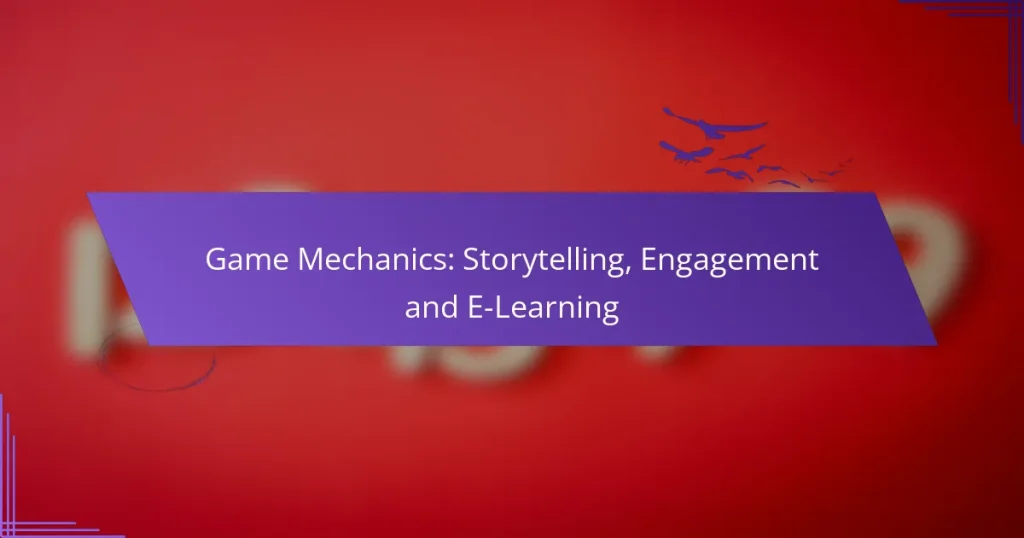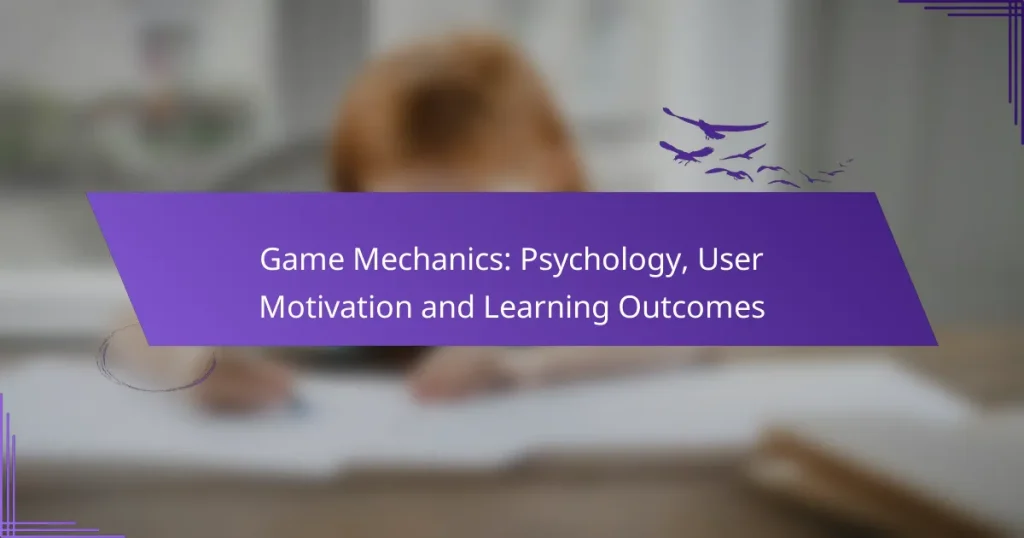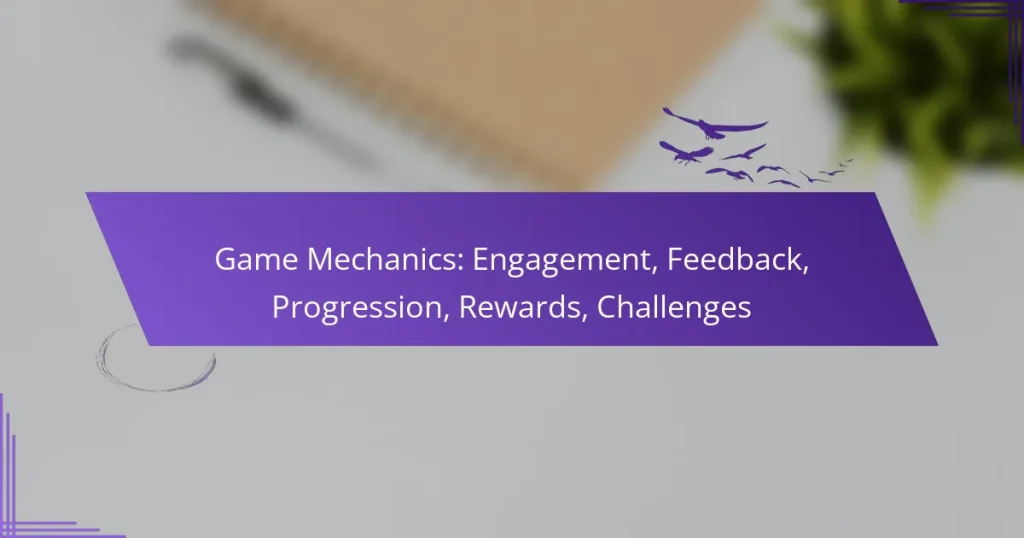Integrating game mechanics into online courses significantly boosts learner engagement and motivation by incorporating elements such as points, competition, and storytelling. This approach transforms traditional learning into a more interactive and enjoyable experience, fostering active participation and better information retention. Various tools are available to facilitate this integration, each designed to enhance engagement and improve learning outcomes in unique ways.
Game Mechanics: Tools for Integration in Learning Management Systems
Game Mechanics: Comparative Analysis in Learning Platforms
Game Mechanics: Psychology, User Motivation and Learning Outcomes
Game Mechanics: Engagement, Feedback, Progression, Rewards, Challenges
Game Mechanics: Effectiveness, Skill Development and Learning Impact
Game Mechanics: Fun and Learning Balance for Adult Education
How to integrate game mechanics into online courses?
Integrating game mechanics into online courses enhances learner engagement and motivation. This can be achieved through various strategies that incorporate elements like points, competition, and storytelling.
Use of points and rewards systems
Points and rewards systems incentivize learners by allowing them to earn points for completing tasks, participating in discussions, or achieving milestones. These points can be redeemed for rewards, such as discounts on future courses or exclusive content.
To implement this, establish clear criteria for earning points and ensure that the rewards are appealing and relevant to the learners. A common approach is to offer a tiered system where learners can unlock higher rewards as they accumulate more points.
Incorporate leaderboards for competition
Leaderboards foster a sense of competition among learners by displaying their rankings based on points earned or achievements unlocked. This can motivate learners to engage more actively with the course material.
When using leaderboards, consider how often they are updated and how visible they are to learners. Weekly updates can keep the competition fresh, while ensuring that the leaderboard is accessible encourages ongoing participation.
Implement badges for achievements
Badges serve as visual representations of accomplishments and can be awarded for completing specific tasks or reaching certain milestones. They provide tangible recognition for learners’ efforts and achievements.
To effectively use badges, create a clear set of criteria for earning them and ensure that they are displayed prominently in learners’ profiles. This not only motivates learners but also encourages them to share their achievements with peers.
Utilize storytelling for engagement
Storytelling can enhance engagement by creating a narrative that learners can relate to and immerse themselves in. This can involve scenarios where learners must solve problems or make decisions that impact the story’s outcome.
Incorporate storytelling elements that align with the course content, making the learning experience more relatable and memorable. For example, using case studies or real-world scenarios can help learners see the practical application of their knowledge.
Apply feedback loops for improvement
Feedback loops provide learners with timely and constructive feedback on their performance, allowing them to understand their strengths and areas for improvement. This can be achieved through quizzes, peer reviews, or instructor comments.
To maximize the effectiveness of feedback loops, ensure that feedback is specific, actionable, and delivered promptly. Regular check-ins can help learners stay on track and feel supported throughout their learning journey.
What are the benefits of game mechanics in education?
Game mechanics in education enhance learning by making it more interactive and enjoyable. They foster a dynamic environment where students are more likely to participate actively and retain information effectively.
Increased student engagement
Game mechanics significantly boost student engagement by transforming traditional learning into an interactive experience. Elements such as points, levels, and badges can create a sense of achievement that encourages students to participate more actively in their education.
For example, incorporating quizzes with instant feedback and rewards can make lessons more appealing. This approach can lead to higher attendance rates and more enthusiastic participation in classroom activities.
Enhanced motivation through competition
Competition is a powerful motivator in educational settings, and game mechanics leverage this by introducing competitive elements. Leaderboards and timed challenges can encourage students to strive for better performance, fostering a healthy competitive spirit.
In practice, educators can implement team-based challenges where students work together to solve problems. This not only motivates individuals but also enhances collaboration and teamwork skills.
Improved retention of information
Game mechanics can enhance information retention by making learning more memorable. When students engage with content through games, they often recall information better due to the emotional and cognitive connections formed during gameplay.
For instance, using role-playing games to simulate historical events allows students to immerse themselves in the subject matter, leading to deeper understanding and long-term retention. Incorporating spaced repetition and rewards for revisiting material can further solidify knowledge retention.
What tools can help with game mechanics integration?
Several tools can facilitate game mechanics integration, enhancing engagement and learning outcomes. These tools range from gamification platforms to comprehensive game design software, each offering unique features tailored for different needs.
Gamification platforms like Kahoot!
Gamification platforms such as Kahoot! are designed to make learning interactive and fun. They allow users to create quizzes and games that can be played in real-time, making them ideal for classrooms and training sessions.
These platforms typically offer features like leaderboards, instant feedback, and customizable content, which can significantly boost user engagement. Consider using Kahoot! for quick assessments or to introduce competitive elements into your training programs.
Learning management systems with gamification features
Learning management systems (LMS) with gamification features integrate game mechanics into educational content delivery. These systems often include elements like badges, points, and progress tracking to motivate learners.
When selecting an LMS, look for platforms that allow for easy customization of gamified elements to suit your audience. Popular options include Moodle and TalentLMS, which offer various gamification tools to enhance the learning experience.
Game design software like Unity
Game design software, such as Unity, provides robust tools for creating immersive game experiences that can incorporate complex mechanics. Unity supports a wide range of platforms, making it versatile for both educational and entertainment purposes.
Utilizing Unity requires some programming knowledge, but it offers extensive resources and community support. For those looking to develop custom games with specific mechanics, Unity is a powerful choice that can lead to highly engaging outcomes.
What are the challenges of implementing game mechanics?
Implementing game mechanics presents several challenges, including the need to balance engagement with educational outcomes. Developers must navigate the complexities of creating enjoyable experiences while ensuring that learning objectives are met effectively.
Balancing fun and educational value
Striking the right balance between fun and educational value is crucial. Game mechanics should engage players without overshadowing the learning goals. For instance, incorporating rewards and challenges can enhance motivation, but these elements must align with the educational content to avoid distraction.
Consider using a framework that prioritizes both aspects, such as the “Edutainment” model, which blends entertainment with educational objectives. Regular playtesting can help identify whether players are enjoying the game while still absorbing the intended lessons.
Ensuring accessibility for all learners
Accessibility is a key consideration when implementing game mechanics. Games should cater to diverse learning styles and abilities, ensuring that all players can participate and benefit. This may involve providing multiple ways to engage with content, such as visual, auditory, and kinesthetic options.
Incorporating features like adjustable difficulty levels, subtitles, and alternative input methods can enhance accessibility. It’s essential to follow guidelines such as the Web Content Accessibility Guidelines (WCAG) to create inclusive experiences for all learners.
Measuring effectiveness of game mechanics
Measuring the effectiveness of game mechanics is vital for assessing their impact on learning outcomes. This can involve collecting data on player engagement, knowledge retention, and skill development through surveys, analytics, and direct observation.
Establish clear metrics before implementation, such as completion rates or improvement in test scores. Regularly review this data to refine game mechanics and ensure they are meeting educational goals effectively. Using A/B testing can also provide insights into which mechanics resonate best with learners.
How to evaluate the effectiveness of game mechanics?
Evaluating the effectiveness of game mechanics involves gathering data on player engagement and performance to determine their impact on the gaming experience. Key methods include collecting feedback, analyzing metrics, and testing variations of mechanics.
Collect student feedback through surveys
Surveys are a direct way to gather player opinions on game mechanics. Design questions that focus on specific aspects of the mechanics, such as enjoyment, clarity, and perceived challenge. Aim for a mix of quantitative ratings and qualitative comments to gain deeper insights.
Consider using tools like Google Forms or SurveyMonkey to distribute your surveys. Keep them concise, ideally taking no more than 5-10 minutes to complete, to encourage higher response rates.
Analyze completion rates and performance metrics
Completion rates and performance metrics provide quantitative data on how players interact with game mechanics. Track metrics such as the percentage of players who finish levels or achieve specific goals, as well as average scores or time taken to complete tasks.
Use analytics tools to visualize this data, making it easier to identify trends. For example, if a significant number of players drop off at a particular level, it may indicate that the mechanics there are too difficult or unclear.
Conduct A/B testing with different mechanics
A/B testing allows you to compare two or more variations of game mechanics to see which performs better. Randomly assign players to different groups, each experiencing a distinct mechanic, and measure their engagement and success rates.
Ensure that the sample size is large enough to yield statistically significant results. This method can reveal preferences and effectiveness, helping you refine mechanics based on actual player behavior rather than assumptions.






